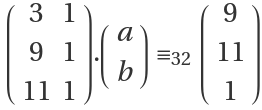Wolfram Function Repository
Instant-use add-on functions for the Wolfram Language
Function Repository Resource:
Solve a linear system with multiple moduli
ResourceFunction["LinearSolveMod"][mat,rhs,moduli] solves the linear system mat.x=rhs for the unknown vector x, with each equation matj . x-rhsj taken modulo modulij. | |
ResourceFunction["LinearSolveMod"][mat,rhs,moduli,True] solves the linear system and returns a list containing the solution vector and a set of vectors that span the null space. |
Solve the system (a+b=0mod2,b+c=0mod2,a+b+c=2mod3):
| In[1]:= |
| Out[1]= |
Check the result:
| In[2]:= |
| Out[2]= |
Solve the linear system :
:
| In[3]:= |
| Out[3]= |
LinearSolveMod can take Gaussian integers for input:
| In[4]:= |
| Out[4]= |
Obtain a solution and a spanning set of null vectors for a modular system:
| In[5]:= |
| Out[5]= |
Solve a simple system of the form x=2mod5,x=1mod7,x=4mod11:
| In[6]:= |
| Out[6]= |
This is equivalent to using ChineseRemainder on the values and moduli lists:
| In[7]:= |
| Out[7]= |
Solve a certain system modulo 29:
| In[8]:= |
| Out[8]= |
The modulus is a prime so LinearSolve can also solve it:
| In[9]:= |
| Out[9]= |
The resource function SmallIntegerSolve can find the solution and also the respective multiples of the modulus that provide it:
| In[10]:= |
| Out[10]= |
Check this:
| In[11]:= |
| Out[11]= |
Solve a system modulo 32:
| In[12]:= |
| Out[12]= |
We learn (noisily) that it cannot be solved using LinearSolve:
| In[13]:= |
| Out[13]= |
Since there is a common modulus, this can be handled using Solve or SolveValues:
| In[14]:= |
| Out[14]= |
Using LinearSolveMod, we can recover the second solution by obtaining the null vectors and adding a certain integer combination thereof to the solution:
| In[15]:= |
| Out[15]= |
Use the nontrivial null vector (the first one) to obtain the second solution given by SolveValues:
| In[16]:= |
| Out[16]= |
Wolfram Language 13.0 (December 2021) or above
This work is licensed under a Creative Commons Attribution 4.0 International License